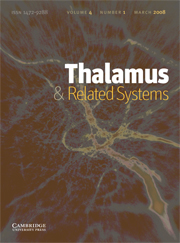Crossref Citations
This article has been cited by the following publications. This list is generated based on data provided by
Crossref.
Vann, Seralynne D.
and
Aggleton, John P.
2004.
The mammillary bodies: two memory systems in one?.
Nature Reviews Neuroscience,
Vol. 5,
Issue. 1,
p.
35.
Jenkins, T.A.
Amin, E.
Brown, M.W.
and
Aggleton, J.P.
2006.
Changes in immediate early gene expression in the rat brain after unilateral lesions of the hippocampus.
Neuroscience,
Vol. 137,
Issue. 3,
p.
747.
Vann, Seralynne D.
Saunders, Richard C.
and
Aggleton, John P.
2007.
Distinct, parallel pathways link the medial mammillary bodies to the anterior thalamus in macaque monkeys.
European Journal of Neuroscience,
Vol. 26,
Issue. 6,
p.
1575.
Méndez-López, Magdalena
Méndez, Marta
López, Laudino
and
Arias, Jorge L.
2009.
Sexually dimorphic c-Fos expression following spatial working memory in young and adult rats.
Physiology & Behavior,
Vol. 98,
Issue. 3,
p.
307.
Vertes, Robert P.
2010.
Handbook of the Behavioral Neurobiology of Serotonin.
Vol. 21,
Issue. ,
p.
277.
Aggleton, John P.
O’Mara, Shane M.
Vann, Seralynne D.
Wright, Nick F.
Tsanov, Marian
and
Erichsen, Jonathan T.
2010.
Hippocampal–anterior thalamic pathways for memory: uncovering a network of direct and indirect actions.
European Journal of Neuroscience,
Vol. 31,
Issue. 12,
p.
2292.
Méndez, Marta
Méndez-López, Magdalena
López, Laudino
Aller, María A.
Arias, Jaime
and
Arias, Jorge L.
2011.
Acetylcholinesterase activity in an experimental rat model of Type C hepatic encephalopathy.
Acta Histochemica,
Vol. 113,
Issue. 3,
p.
358.
Albo, Zimbul
Di Prisco, Gonzalo Viana
and
Vertes, Robert P.
2011.
Electrophysiological Recording Techniques.
Vol. 54,
Issue. ,
p.
191.
Wright, Nicholas F.
Vann, Seralynne D.
Erichsen, Jonathan T.
O'Mara, Shane M.
and
Aggleton, John P.
2013.
Segregation of parallel inputs to the anteromedial and anteroventral thalamic nuclei of the rat.
Journal of Comparative Neurology,
Vol. 521,
Issue. 13,
p.
2966.
Żakowski, W.
Równiak, M.
and
Robak, A.
2014.
Colocalization pattern of calbindin and cocaine- and amphetamine-regulated transcript in the mammillary body–anterior thalamic nuclei axis of the guinea pig.
Neuroscience,
Vol. 260,
Issue. ,
p.
98.
Aggleton, John P.
Saunders, Richard C.
Wright, Nicholas F.
and
Vann, Seralynne D.
2014.
The origin of projections from the posterior cingulate and retrosplenial cortices to the anterior, medial dorsal and laterodorsal thalamic nuclei of macaque monkeys.
European Journal of Neuroscience,
Vol. 39,
Issue. 1,
p.
107.
Jankowski, Maciej M.
Passecker, Johannes
Islam, Md Nurul
Vann, Seralynne
Erichsen, Jonathan T.
Aggleton, John P.
and
O’Mara, Shane M.
2015.
Evidence for spatially-responsive neurons in the rostral thalamus.
Frontiers in Behavioral Neuroscience,
Vol. 9,
Issue. ,
Dillingham, Christopher M.
Frizzati, Aura
Nelson, Andrew J.D.
and
Vann, Seralynne D.
2015.
How do mammillary body inputs contribute to anterior thalamic function?.
Neuroscience & Biobehavioral Reviews,
Vol. 54,
Issue. ,
p.
108.
Żakowski, Witold
2017.
Neurochemistry of the Anterior Thalamic Nuclei.
Molecular Neurobiology,
Vol. 54,
Issue. 7,
p.
5248.
Żakowski, Witold
Zawistowski, Piotr
Braszka, Łukasz
and
Jurkowlaniec, Edyta
2017.
The effect of pharmacological inactivation of the mammillary body and anterior thalamic nuclei on hippocampal theta rhythm in urethane-anesthetized rats.
Neuroscience,
Vol. 362,
Issue. ,
p.
196.
Tsanov, Marian
2018.
Handbook of in Vivo Neural Plasticity Techniques.
Vol. 28,
Issue. ,
p.
153.
Sweeney-Reed, Catherine M.
Buentjen, Lars
Voges, Jürgen
Schmitt, Friedhelm C.
Zaehle, Tino
Kam, Julia W.Y.
Kaufmann, Jörn
Heinze, Hans-Jochen
Hinrichs, Hermann
Knight, Robert T.
and
Rugg, Michael D.
2021.
The role of the anterior nuclei of the thalamus in human memory processing.
Neuroscience & Biobehavioral Reviews,
Vol. 126,
Issue. ,
p.
146.
Phillips, Jessica M.
Kambi, Niranjan A.
Redinbaugh, Michelle J.
Mohanta, Sounak
and
Saalmann, Yuri B.
2021.
Disentangling the influences of multiple thalamic nuclei on prefrontal cortex and cognitive control.
Neuroscience & Biobehavioral Reviews,
Vol. 128,
Issue. ,
p.
487.
Nelson, Andrew J.D.
2021.
The anterior thalamic nuclei and cognition: A role beyond space?.
Neuroscience & Biobehavioral Reviews,
Vol. 126,
Issue. ,
p.
1.
Aggleton, John P.
Nelson, Andrew J.D.
and
O’Mara, Shane M.
2022.
Time to retire the serial Papez circuit: Implications for space, memory, and attention.
Neuroscience & Biobehavioral Reviews,
Vol. 140,
Issue. ,
p.
104813.

